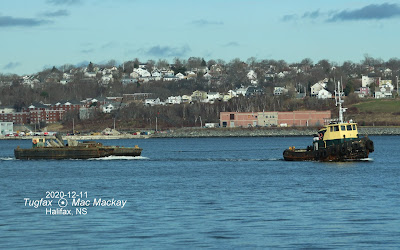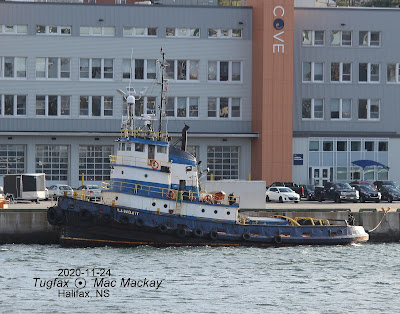The history of ship preservation in this country and many others is unfortunately a tale of woe, as enthusiasm often could not be backed up with money. Good intentions have all to often "run aground" and the wrecks are many and the stories sad.
The number of suitable candidates for preservation diminish as the years go by, and so the opportunities to save significant vessels will be fewer and fewer. Smaller vessels may be preserved (Russel Brothers logging tugs come to mind), but the larger vessels require much more money, expertise, and professional management than many enthusiasts can muster.
Time has just run out for one significant class of Canadian built naval tugs, as the last of Norton class tugs in Canada is now gone. Not only was it the prototype of the class, it was in full commercial service and well maintained, in fresh water, until very recently. If there was ever a tug that could have been preserved this was it. It has just been scrapped since there were no funds to preserve it.
During World War II the demand for tugs was considerable. The huge increase in transatlantic shipping and the growth of the Royal Canadian Navy meant that all available civilian tugs were pressed into service, and new tugs were needed desperately. Several classes of tugs were designed for the RCN, both small "Pups" (the Ville class) and dockyard berthing tugs (Glen class) and they were churned out in large numbers. However the RCN needed bigger ice class tugs for target towing, coastal towing and salvage and thus the Norton class came into being. Despite much war time construction being "for the duration" and not particularly durable, these tugs were built to high spec British Corporation standard and were intended to serve for many years in peacetime - and they did.
HMCS Riverton in St.John's. There were eight tugs in the class, fitted with 1,000 bhp Sulzer engines, built under license by Dominion Steel Co (DOSCO). They carried a 1.5 ton capacity derrick, a towing winch, and were armed with a Lewis gun. War time compliment was 26 including gun crew.
CNAV Riverton in Halifax.
All eight tugs were completed in 1944 and commissioned into the RCN. See attachment for some of Norton's wartime explots. Note its skipper was Capt Wally Myalls, RCNVR, one of the people who figured in Farley Mowat's book Grey Seas Under.
http://www.forposterityssake.ca/Navy/TUG-NORTON_W31.htm
At war's end four of the Norton class tugs were transferred to the Canadian Naval Auxiliary Service. They were crewed by civilians and continued to serve the RCN under the direction of the Queen's (or King's) harbour master. Four were transferred to the War Assets Corporation for disposal.
CNAV Riverton underway
Interestingly Norton was one of the latter, but was not sold immediately. It was laid up in Sydney, NS and in December 1945 it was renamed W.A.C.1 and chartered to Foundation Maritime's managing arm Maritime Towing + Salvage Ltd. It was used to tow surplus naval craft for disposal or scuttling at sea and assisted in some salvage work until March 1946.
In 1946 Marathon Paper Mills Ltd bought the tug, and transferred it to Lake Superior where it was refitted in Fort William with upgraded civilian accommodation. It was renamed Peninsula and put to work towing log rafts of 8,000 cords from booming grounds to storage ponds. From time to time it towed gigantic log booms of up to 25,000 cords from Port Arthur to Marathon - a 12 to 14 day operation.
In 1967 Western Engineering Service of Thunder Bay acquired the tug for ship berthing in the port of Thunder Bay. With the name unchanged, it operated through Gravel and Lake Services until it was retired in 2015. Its certificate of operation expired in late 2017.
It was then that the Marathon and District Historical Society arranged to take over the tug and to preserve it on dry land. Peninsula sailed under its own power, and beached itself at Marathon in July 2018.
There the tug has languished, settling over on one side, raising concerns about its future. In June of this year the town of Marathon applied to have the vessel demolished, and by August had taken over ownership. On November 12 demolition work was well under way and nothing but shreds remains now.
https://www.cbc.ca/news/canada/thunder-bay/marathon-peninsula-tug-dismantled-1.5728432
The Nortons
(built by Montreal Drydock, a subsidiary of Canadian Vickers, unless noted)
Alberton W48 1948: sold to Cia Navegaçao, Portugal, renamed Aveiro, broken up 1990s.
Beaverton August 27, 1946, sank in collision with Empire McAlpine off Cap-aux-Oies, QC.
Birchton W35. 1946: sold to Marine Industries Ltd, Sorel, QC, renamed Capitaine Simard. 1978: Sceptre Dredging, laid up, 1981: Techno-Maritime Ltée - stripped for parts. Broken up 1982.
Sisters, ex Birchton (left) and Riverton at Quebec City.
Clifton (built by Canadian Bridge, Walkerville, ON). 1946: Canadian Naval Auxiliary Vessel, ATA 529, based Esquimalt. 1968: North Arm Transportation, 1981: Horton Maine Explorations, then various owners, in Florida then broken up in Progreso, Mexico.
Heatherton 1946: CNAV ATA 527, based Esquimalt. 1975: Minister of Public Works, 1977: Three Rivers Boatmen, Trois-Rivières, QC, renamed Robert-H. 2001: sold Inlogmar, renamed Kellan Pacific Ecuador flag. 2019: sold to Sorepor SA, renamed Rio Amazonas, Ecuador flag.
Maxwellton (built by Canadian Bridge, Walkerville, ON) 1946: Price Navigation, renamed Hugh Jones. Dismantled by MIL and rebuilt on Lac St-Jean for log raft towing. 1973: bought by Three Rivers Boatmen Ltd, dismantled, trucked to Chicoutimi, reassembled. November 23, 1973 sank off St-Irenée, QC on delivery trip to Trois-Rivières.
Norton 1945: War Assets Corp. Renamed W.A.C.1 (Maritime Towing + Salvage, managers). 1946: sold to Marathon Paper Mills Ltd, renamed Peninsula. 1967: sold to Western Engineering Service Ltd., Thunder Bay, ON. 2017: sold to Marathon and District Historical Society, beached Peninsula Harbour, Marathon, ON. 2020: acquired by Town of Marathon and scrapped.
Riverton W47 (built by Chantier Maritime du St-Laurent under sub-contract to Canadian Bridge Co) 1946: Canadian Naval Auxiliary Service ATA 528, based Halifax. 1979: sold to Techno-Maritime Ltée, Quebec City, renamed Techno-St-Laurent. 2001: sold to McKeil Workboats, Hamilton, ON, unofficial rename Kirstin. 2014: broken up Port Colborne, ON.
Techno-St-Laurent ex Riverton hauled out at Ile-aux-Coudres, QC.
.




















































